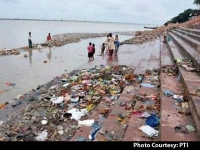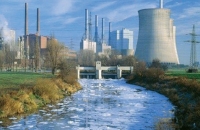Does River Cleansing Sounds Like Augean Stable Clean Up?

To serve Maa Ganga or to cleanse River Ganga we need to educate, empower, and engage the youth through creative internships.
We hear diverse news on cleaning Ganga River. The nation has 1067.4 million population, and we can expect only increase in population, certainly not decrease like European countries that face population de-growth. There is no need to tell we need more water and conserve or reuse the existing water to meet the requirements of the massive population. As Dr. A.P.J Abdul Kalam’s birthday is falling on October 15, it is important to ignite the youth with innovative ideas on River Ganga clean up that needed concerted efforts.
Need a Case Study Approach
The main stakeholders are people as well as industries who are also beneficiaries of water resources. As the Ganges pass through Prime Minister’s constituency, he should be more concerned to provide safe drinking water for humans. For quite some time, there has been a focused approach on cleansing Ganga to sustain people and industries. Now the question is how far River Ganga is cleansed despite all measures or what hinders National Mission for Clean Ganga from achieving its mission? To gauge the success metrics, we need to analyze various aspects.
Cleanse Ganga by 2019!
Prime Minister Narendra Modi wants a time-bound action plan to cleanse Ganga by 2019. To some of the opposition party leaders, this is ‘impossible task.’ Let us gain more insights through research. In August 2017, Union Government approved Clean Ganga Mission that has ten projects worth of Rs 2,000 crore. Since the project is in its incipient stages, it makes sense to infuse new ideas or give suggestions to spend the funds worthy as the large section of people are looking for clean water from Ganga.
Pollution Facts
We need to check facts. In March 2017, The Central Pollution Control Board has identified 1,000 polluting industries. According to findings, nearly 500 million litres of effluents are discharged daily into the Ganges. The municipal sewage generation from the 118 towns along the river in five states is estimated at 4,790 MLD. Coupled with this is the throwing of thousands of animal carcasses and human corpses into the river every day. Learn more, the levels of Coliform bacteria are over 2800 times in Ganga. This shows the urgency to deal with the situation networking all stakeholders.
Nobody will doubt the sincere intention of the government in cleansing rivers. Now think, what makes sense: just cleansing the river makes sense or changing the habits of people who pollute the river makes sense. We can understand this more by looking into an analogy on Augean stable clean up in Greek mythology.
Can One Cleanse Augean Stable?
King of Tiryns, Eurystheus ordered Hercules to clean Augean stables. Let us check what was the challenge in the Augean stable? Augean, the King of Elis, owned a large livestock that slept in the royal stables not cleaned for several years together. First of all, much water was needed to cleanse the filth. The second thing is the more he tried to clean the stable the more contamination from other side emerged because the cattle kept on producing the pollution. So, the only solution for him was to divert the course of nearby rivers with his enormous strength.
The lesson here is, we can put our money and resources to cleanse Ganga. But, if people behave like the livestock in Augean stables, what is the use? If River Ganges made squeaky clean with purified water also, in a few days, the same old pollutants will come back with revenge and make the river pollute once again. This means, what should we do?
The Challenge is in Changing the People’s Habits
Put it directly. The need of the hour is to change the habits of people. As the Prime Minister has announced Clean Ganga package in August 2017 only, it is indeed practical to cleanse the holy river in right earnest. Esteemed Prime Minister, you are sincere in your statement, “My destiny to serve Maa Ganga.” If this message percolates down to the masses and they change their habits, it is indeed possible to cleanse not just river Ganga, but hundreds of other rivers in the country too.
It is important that citizens and industries develop River Cleansing habits save people from the toxic water, polluted water, and make it fit for drinking and irrigation purposes. River Ganga provides water to more than 40% of the country’s population. According to Ministry of Statistics and Programme Implementation Government of India, nearly 40 percent of the population comprises youth. My suggestion is to explore the public, private partnership to harness the power of young people and giving them direction in activities like Clean Ganga Mission.
Is Water Internship, a Way to Go?
In my capacity as a founding member of Walkforwater Foundation, we have been promoting ‘water internship’ to promote water conservation and other allied activities in Telangana. Let us discuss water internship for a mega project like Clean Ganga
Mission.
Water internship is a concept where education institutes should harness youth energy to percolate down ‘river water cleansing messages.’ Some of the
areas identified include:
- Discourage throwing dead bodies in the river. Keep banners in various places with the message of the relevant leaders. This can include Prime Minister, celebrities, and educators to name a few.
- Write letters to small and medium industries to avoid sending their industrial effluents to rivers.
- Conduct seminars locally on creative themes to conserve water, cleanse water, awareness of diseases spread through water, and how Ganga is one among the top polluted rivers.
- Create student editors in respective institutions to gauge feedback, reward those who accomplished in educating people, communities, etc.
- Invite youth to generate ideas on changed scenarios like what next after achieving one particular goal.
- Water interns should promote rural sanitation to arrest solid & liquid pollutants entering river through the construction of toilets and recycling of wastes.
- Interns should research on reducing the effluent volume through fact-finding, consulting.
- Promoting awareness to construct more crematoria nearby rivers.
- Encourage students to research on enhancing treatment capacity of municipal wastage.
- Since pollution is a cycle, there should be a cyclic rotation of ideas, implementation, results, evaluation, and repeat.
We Should Not Allow River Pollution to Defeat Us
If water internship implemented innovatively in a constituency like Varanasi other cities also can emulate the same pattern. Addressing issues like river cleansing is not an easy task. But with the engagement of youth on a massive scale networking many sectors like government, businesses, communities, youth, and citizens we can achieve things that appear impossible like cleaning Augean stables.
To gain motivation let us turn to Dr. A.P.J. Abdul Kalam who said, “We should not give up, and we should not allow the problem to defeat us.” Dr. Kalam emphasized on river linking in his Vision 2020. We need to be linked rivers with clean water where pollution should not defeat us taking along Vision 2020 and Beyond. To serve Maa Ganga envisioned by the Prime Minister, this is highly relevant. Isn’t it?
Karunakara M Reddy





Karunakara M Reddy
Videos
Videos
Videos
@ignitingmindsmagazine
@IgnitingMindsin
Top Stories
- Dedicated to the Sparrows, Forests and Water
- The United Nations Decade of Ecosystem Restoration
- How technology in agribusiness affects climate change, a concrete solution.
- Restless Youth Seek Climate Action
- Telangana Jagruthi International Youth Leadership Conference 18,19,20th January 2019
- Sports for Climate Action Framework launched at COP24
- COP24: One Week of Misgivings
Videos
Businesses
- Can Home Remedies Increase Your Height.
- Success Comes When We Make Innovation a Habit
- Do You Want to Be a Green Entrepreneur?
- Igniting Minds Official Web Portal Launched in New Delhi.
- Strive To Drive The Life
- Do Mobile Apps Facilitate Small Businessmen?
- Water Conservation, Preservation and Restoration. A Global Engineering Challenge.